Big Upsides to Downstate Gaming: Union Jobs and Transit Revenue

(photo: Governor's Office)
New York has a proud history of thinking big and building bold. As New York searches for routes to generate new revenue to fund critical priorities, and drive job growth through significant private investment projects, we have an unparalleled opportunity right in front of us.
Albany leaders should lift the moratorium on the expansion of casino development downstate and begin an open competition for the remaining three gaming licenses as approved by New York voters in 2013. No other opportunity is currently on the horizon to provide the infusion of jobs or revenue New York would experience with a robust, competitive, and transparent process to expand gaming downstate.
Surrounding states have taken advantage of New York’s moratorium on downstate gaming by moving quickly to expand gaming and produce new jobs and revenue for themselves.
Boston is putting the finishing touches on a $2 billion resort and gaming complex, with 4,000 permanent jobs and 5,700 construction jobs – good union jobs. Pennsylvania has seen $400 million in new revenue over the past year after enacting a broad gaming expansion. New Jersey is seeing $20 million a month in new revenue from sports betting alone, and Connecticut is considering gaming expansion in Bridgeport and on the New York border. And, ironically, New Yorkers who have limited gaming opportunities in their own state are often the ones funding tax revenues and job growth in neighboring states.
With due respect for our neighbors from Boston to Bridgeport, New York, with 60 million tourists a year to the City, is the single most attractive new market for gaming in the United States. Let’s show we can do it big and do it right: instead of a private company pitting cities against each other in a bidding war, let’s have private casino companies compete with each other for the right to valuable resort gaming franchises in New York.
A New York gaming development license is an extraordinarily valuable asset if structured correctly with a competitive process for three licenses that:
-Establishes a minimum license fee of $500 million per license -- totaling $1.5 billion in upfront revenue;
-Sets a minimum private investment of $2 billion per license -- bringing in $6 billion in private investment;
-Requires union labor on construction jobs and the right for unions to organize permanent operations jobs; and
-Dedicates new revenue to improve public transit service, fund public education, and other New York priorities.
If done right, releasing the remaining three licenses in a competitive bid process will generate tens of thousands of good union jobs and billions in revenue for the City and the State without any federal, state or local subsidies. And it would provide local and accessible economic opportunities for communities that are too often shut out.
The estimated $1.5 billion in up-front license fees from casinos could be dedicated immediately to fund public education or to help close the revenue gap needed for the MTA. If the State moves quickly, this revenue could be available in the next fiscal year. Additional, ongoing revenue from gaming and real estate taxes could be dedicated to fund crucial programmatic priorities – without any subsidies, and no additional taxes or fees on New Yorkers.
A significant private investment requirement of $2 billion for each gaming resort development (on top of license fees) would create a projected 16,800 permanent career union jobs, and an additional 15,000 union construction jobs. These are good jobs, benefiting a diverse union workforce with quality benefits including healthcare, training, and secure career opportunities.
Think about it: $6 billion in private development to fund critical needs. Built and operated by local union labor. No subsidies. Keeping New York dollars in New York. If you created the wishlist for future development in New York, you couldn’t do better. New York has the winning hand when it comes to making the most of the gaming licenses already approved by New York voters: Let’s play it.
***
Gary LaBarbera is President of the Building and Construction Trades Council of Greater New York. John Samuelson is International President of the Transport Workers Union (TWU).
***
Have an op-ed idea or submission for Gotham Gazette? Email This email address is being protected from spambots. You need JavaScript enabled to view it.
New York Construction Workers Remain at Risk Without Legislative Action
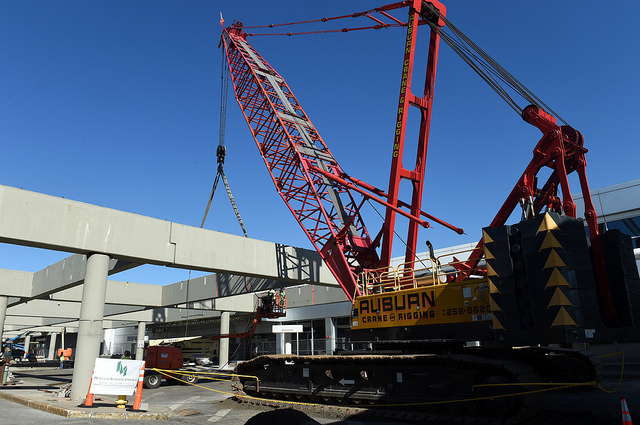
(photo: Kevin P. Coughlin/Governor's Office)
With this year’s legislative session in full-swing in Albany, special interest groups have resumed their attacks on laws designed to keep workers safe on construction sites. Construction and insurance trade groups, seeking to shed accountability and pad their pockets, have argued that labor protections like the Scaffold Safety Law are somehow undermining worker safety. However, a recent data analysis by the New York Committee for Occupational Safety & Health (NYCOSH) confirms that stronger safety requirements in New York City are helping to reduce on-the-job fatalities while worker deaths continue to rise in other, less-regulated parts of the state.
In 2017, the most recent data year available, the construction fatality rate across New York State was 52% higher than in New York City, according to our analysis of federal and city data. This significant difference in fatalities is not an outlier, but rather the continuation of an ongoing trend. Over the past five years, New York State’s construction workers have experienced a 39% increase in fatal injury rates compared to a 23% decrease in New York City. The stark gap in safety outcomes can be explained by the city’s more pronounced enforcement of safety regulations, which has helped to deter contractors from cutting corners and putting workers’ lives at risk.
Underfunding has constrained the federal Occupational Safety & Health Administration’s ability to conduct worksite inspections and enforce penalties for safety violations. In response, New York City officials have allocated more funding to the city’s Department of Buildings, boosting the agency’s budget from $107 million in 2015 to $183 million in 2019 and increasing its personnel from 1,156 employees in 2015 to 1,880 this year. Armed with larger staff and additional resources, the agency has expanded its ability to identify construction safety hazards and hold negligent contractors accountable.
The Manhattan District Attorney’s office has stepped up as well, prosecuting severe offenders through the Construction Fraud Task Force. By prosecuting bad actors for wage theft and dangerous labor violations, the DA’s office indicated that contractors are not above the law, especially when they are putting lives at risk. Beyond a more proactive approach to enforcement, the city has also encouraged employers to prioritize proper safety education by mandating that workers complete specific training and certification requirements.
At the state level, officials must uphold existing safety provisions and enact additional protections in order to reduce fatalities outside of New York City.
It’s imperative that lawmakers preserve the Scaffold Safety Law, which allows construction workers to hold negligent contractors responsible when serious injuries or fatalities do occur. The law simply calls for contractors to ensure that workers have access to proper safety equipment. If a failure to provide safety equipment leads to injury, workers are able to then hold the contractor responsible for the lost wages and medical bills that result. The Scaffold Safety Law is a crucial mechanism that deters contractors from cutting corners on safety equipment and promotes accountability.
In addition to maintaining the Scaffold Safety Law, policymakers should create a statewide vehicle to enforce labor protections and overcome the limitations of federal regulators. To that same end, the state Department of Labor should implement a registry of workplace fatalities to foster public transparency, as well as implement Carlos’ Law to increase the maximum fines that can be levied against negligent contractors.
The state would be wise to borrow a few lessons from New York City, by expanding the number of prosecutions for cases of severe employer misconduct and requiring construction workers to undergo training and certification.
The latest data offers a glaring reminder that construction remains a dangerous profession, particularly in the absence of meaningful regulations. At the same time, the decrease of fatality rates even when coupled with an ongoing construction boom in New York City indicates that stronger safety protections can save lives without stunting the industry’s growth.
For those who are committed to protecting the lives of New York’s working families, there is a clear path forward to improving construction safety centered on increasing worksite inspections, enforcing stronger penalties, and expanding workers’ access to safety equipment and resources.
***
Charlene Obernauer is the Executive Director of the New York Committee for Occupational Safety & Health.
***
Have an op-ed idea or submission for Gotham Gazette? Email This email address is being protected from spambots. You need JavaScript enabled to view it.
Ending The School Aid Charade
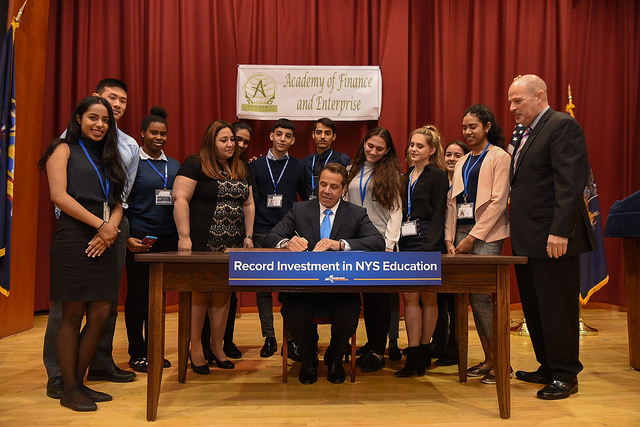
(photo: governor's office)
It is budget season in New York State and the annual game of determining the amount of state aid each of the 674 school districts will receive is in full swing. Every district and its legislators will fervently argue that more school aid is needed, that its schools are underfunded, and that its students will suffer serious harm if more money isn’t devoted to them as soon as possible. But in fact, the vast majority of New York’s schools are generously funded, while our results in terms of achievement are only mediocre. Instead of targeting additional aid to the few truly needy districts, all are given more.
As is the case in most states, New York public schools are primarily a local responsibility. Each school district runs its own schools, has its own contract with the teachers union, and relies on local property taxes to fund a large part of its costs. State school aid is meant to supplement the local tax contribution so that children in ‘low wealth’ districts are not denied the ‘sound basic education’ guaranteed by the State Constitution.
Each year a chorus of school advocates including the teachers union, school administrators, and state legislators argue for more state school aid. Whatever increase the Governor proposes is inevitably denounced as too little. The higher amount recommended by the State Education Department (SED) (controlled not by the Governor but by the Legislature via the State Board of Regents) is also decried as too low. Inevitably, some compromise amount is set in the state budget that is always a significant increase over the prior year.
The total amount of legislatively-approved school aid statewide rose 32% percent over the ten years between 2006 and 2017 and totaled more than $28 billion in fiscal year 2018, the largest expense in the state’s operating funds budget. Combined with local allocations, New York State school districts now spend a whopping $69 billion a year, an average of more than $25,000 per student, by far the highest amount in the country.
The game in its current form has been played since 2011, following the recession of 2008 when across-the-board school-aid cuts were imposed, when the Governor and the Legislature agreed to an annual ‘cap’ on the growth of school aid tied to growth in personal income and used a ‘foundation formula’ to determine the amount of aid each district would get, based on its number of poor students, English language learners, students with disabilities, regional cost differences, property values, and wealthy residents.
But the cap has never really been adhered to, and the results of the foundation formula are undermined through the addition of other kinds of aid (e.g. transportation, high tax aid) and foundation aid ‘hold harmless’ provisions ensuring that no district ever loses aid and indeed, that all get at least some increase each year no matter what they spend.
Why does this game go on? First, school aid is the primary vehicle for state legislators to ‘bring home the bacon’ and demonstrate effectiveness to their voters. The wealthiest school districts are in suburban areas where residents have shown the value they attach to top quality schools by paying very high property taxes. Even though these districts are already spending outsized amounts per pupil on their schools, they want more and their representatives need to get it for them. The Governor needs the support of these legislators for other parts of his agenda, so he is loath to disappoint them.
Second, public education advocates continue to make the argument that there are unmet school needs as revealed by the shortfall between aid amounts and what would have been provided under the foundation formula had it continued to be applied as approved in a lawsuit filed by a consortium known as the Campaign for Fiscal Equity (CFE).
The lawsuit ended in a settlement in 2007, and, while clearly articulating the right of all children in New York to free quality education, did not legally require implementation of its calculations of optimum aid. The Governor has called the CFE aid formula a ‘ghost of the past’ but the state teachers union and an alliance of other advocacy groups continue to insist that there is a shortfall of at least $4 billion in state school aid.
It is true that some school districts are underfunded and should receive more state aid to make up for their high number of poor students and their low property tax wealth. But there are less than 35 districts in this category and their unmet needs total less than $200 million. This shortfall could easily be filled by re-allocating a small part of the money that is going to school districts that do not need it; they are already spending far more than enough.
The 62 wealthiest districts in New York are receiving almost $5,000 a year in state school aid and are spending an average of $30,500 per student per year. The 68 poorest districts are getting much more aid – an average of $15,700 per student – but because they don’t have sufficient local resources, they can spend only $22,000 per student per year. There is no educational reason to give the wealthier districts any aid, and certainly no more than they are getting.
Surely, everyone involved in setting school aid amounts knows this. But the CFE advocates don’t want to alienate a large of portion of their support from the wealthy districts by arguing only for targeted aid increases and the legislative representatives of the well-funded school districts are certainly not going to kill the golden goose. So we continue with a charade of hand-wringing about the need for more school funding state-wide.
This year Governor Cuomo has proposed almost $1 billion in additional aid, SED wants more than $2 billion more, and the CFE groups are still demanding $4 billion. The reality is there is no justification for more state school aid, it just needs to be re-allocated and targeted to the specific districts that are actually needy. But more school aid there surely will be. This is especially infuriating when the Governor is proposing to reduce spending on Medicaid to address an expected $2.3 billion revenue shortfall in the next fiscal year.
In his second State of the State address, in 2012, Governor Cuomo complained that all the adults in the public school system have lobbyists pressing for more spending and that he would now be the students’ lobbyist. But over time, he has made compromises with the political realities; while his school aid proposals are accompanied by rhetorical acknowledgement of the need for better targeting, the chorus of calls for everyone everywhere in the state to receive more school funding continues. It is well past time for this charade to end.
***
Carol Kellermann was president of Citizens Budget Commission from 2008 through 2018.
***
Have an op-ed idea or submission for Gotham Gazette? Email This email address is being protected from spambots. You need JavaScript enabled to view it.
Prevailing Wage Extension Would Kill Jobs and Limit Housing for New Yorkers

(photo: governor's office)
If there’s one thing that New Yorkers can agree on, it’s that we should always strive to create new jobs, not take them away. Amazon’s recent decision to withdraw its planned “HQ2” from Long Island City is an example of us failing on this front. However, public officials still have an opportunity to redeem themselves by protecting local workers from a proposed prevailing wage expansion.
Discussions are currently underway in Albany to extend prevailing wage requirements to private construction projects and could cost New York City thousands of jobs. Elected officials should heed the warnings of community leaders and push back against powerful unions that are advancing their own agenda at the expense of New York’s working class.
The dangers of expanding the prevailing wage to private work projects are numerous. First, advancing this initiative neglects to consider the negative consequences it will have on the city’s working families. In the past, Governor Cuomo has said, “Construction with public subsidies should be subject to the prevailing wage so they’re built right, they’re built fairly, they’re built union.” However, there’s no guarantee that this requirement will result in projects being built right and fairly—instead, the only thing it assures is that non-union workers are forced out of the hiring pool as developers are forced to hire union.
As a result, any efforts to extend the prevailing wage to private projects directly impacts workers of color, who make up the majority of the non-union workforce. Per industry data, roughly three quarters of non-union workers are either black or Latino and live in one of the city’s five boroughs. This is in part due to the fact that unions have historically imposed barriers to entry for people of color, which persist to this day. Just two months ago, for example, six African-American engineers at the LaGuardia Airport renovation project filed a lawsuit against the Operating Engineers Local 15 chapter for alleged discriminatory hiring practices and treatment by union supervisors.
Beyond the detrimental effects it would have on minority workers, instituting a prevailing wage requirement at private projects would actually diverge from the dominant trend in the city’s construction industry. According to our analysis of building permit numbers provided by the city, approximately 80 percent of private construction work is now being done by non-union workers.
Additionally, these workers have secured benefits on par with those of union members. On average, they earn $20 per hour, competitive health care packages, and 401(k) packages that allow them to secure their futures. Therefore, contrary to some misconceptions, opposition to prevailing wage does not equate disregard for workers’ rights.
Expanding the prevailing wage would also have a harmful effect on housing opportunities for many of these non-union workers. New York has an affordable housing shortage, and a prevailing wage will only make this housing crisis worse. The Independent Budget Office found that a prevailing wage requirement would increase construction costs by 23 percent. Additionally, such an increase would significantly alter Mayor de Blasio’s plan to create 80,000 desperately needed new affordable housing units, or simply cost an additional $4.2 billion.
Ultimately, those same hard-working New Yorkers who are being left out of prevailing wage discussions are the ones who stand to be affected most by it. Our elected leaders should stand up to powerful union interests and their agenda by securing the economic well-being of the construction industry and the workers that build it up.
***
Clark Peña is Director of Advocacy at the Construction Workforce Project. On Twitter @CWPNYC.
***
Have an op-ed idea or submission for Gotham Gazette? Email This email address is being protected from spambots. You need JavaScript enabled to view it.
Addressing the Crisis of Family Separation Here in New York

It is time to address the crisis of family separation. This time, it’s not about the humanitarian emergency on our nation’s southern border, but our own homegrown crisis that affects New York’s approximately 80,000 children with a parent in prison. Most of these children deeply miss and want to visit their mothers or fathers, yet distance is a barrier, and many of New York’s 54 prisons are not accessible by public transportation.
Time and again, constituents from across the state have asked us for help. Grandmothers like Mrs. Coleman who was unable to take her grandchildren in Brooklyn to see their mother when she was incarcerated near the Canadian border. She once drove through the night so as not to miss school and work, her grandchildren asleep in the back, and scarily, almost fell asleep at the wheel. Children like Jeremiah and Jonathan, who used to see their father monthly when he was an hour away by MetroNorth, but now have no affordable way to travel 10 hours to see him. And Brianna and Isaiah, from Buffalo, who have seen their mother only once since she was moved to Taconic Correctional Facility, almost 400 miles away.
There are four bills before the New York Senate and Assembly that would address these issues: the Visiting Bus, Proximity, Restoring 7 Day Visiting, and Codifying Visiting bills will improve children’s access to their parents, strengthen family connections, and promote the correctional and public safety goals of rehabilitation and successful reentry. Many prison officials—including former Corrections Commissioner Brian Fischer—report that visiting improves the prison environment, promotes program participation and rehabilitation, and increases the likelihood of successful reentry.
The Visiting Bus bill restores free transportation for families visiting a New York State Prison. In 1973, in the aftermath of the Attica Uprising, New York State undertook a series of reforms that included these free visiting buses. The buses operated for 38 years until their funding was eliminated from the state budget in 2011.
Visiting buses are more cost-effective and less onerous on families if people need not travel great distances to visit a loved one. The Proximity bill will place parents in the prison as close to their children as possible if the parent, the child, and the child’s caregiver also agree, and only after the state corrections department’s existing assignment criteria of security, health, and programming needs are satisfied.
When prison visit rooms are open every day, families have more flexibility to visit as well as to visit two days in a row, making the most of their time and resources they spent to travel to the facility. Only maximum security prisons currently offer visiting every day. The Restore 7 Day Visits bill would remedy this. New York State has long been a national leader in offering in-person visiting. The Codifying Visiting bill ensures in-person, contact visits are a right throughout New York that cannot be replaced by video visiting.
Taken together, these bills strengthen a lifeline between parents and children who often grapple with their parent’s incarceration in isolation, fearing someone will find out and treat them differently as a result. Visiting lessens this isolation and stigma, maintains the parent-child relationship, and allows children to see others in the visiting room and realize they are not alone.
This is not simply a downstate issue. Today, 60% of incarcerated women and 50% of incarcerated men in state prisons come from areas outside of New York City. It affects all of us, and it is up to all of us to ensure that no family will have to choose between bringing a child to see his or her parent or putting groceries on the table.
Just as Mrs. Coleman and her grandchildren have asked us for help, we urge our colleagues in the Legislature and Governor’s office to pass these bills, fund the visiting buses, and strengthen this lifeline for thousands of children and families.
***
Assemblymembers Carmen De La Rosa and David Weprin are a member and the chair, respectively, of the New York Assembly Committee on Correction. On Twitter @CnDelarosa & @DavidWeprin.
***
Have an op-ed idea or submission for Gotham Gazette? Email This email address is being protected from spambots. You need JavaScript enabled to view it.
Lobby Laws Should Empower the Grassroots, Not Big Money
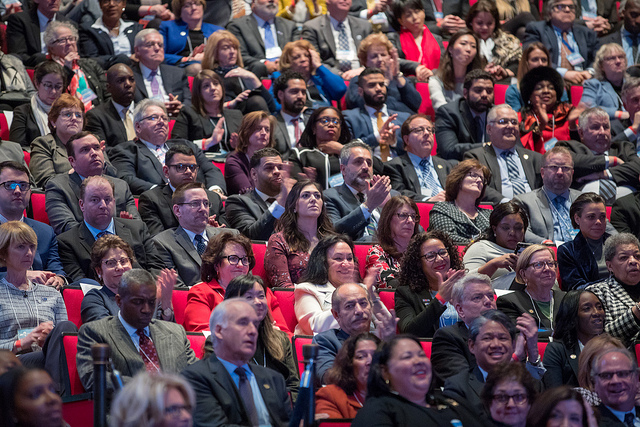
(photo: Governor's Office)
Imagine two New Yorkers heading to Albany for a day of advocacy.
One is a lobbyist with multiple clients, traveling to the Capitol in Amtrak business class for the third time that week. She’s spent a career working behind the scenes with elected officials trying to influence legislation and get favorable treatment for her clients. The other is an entry-level employee at a homeless shelter, sitting in a coach bus filled with clients and nonprofit service providers. It will be his first-ever meeting with an elected official.
The average New Yorker understands that these two New Yorkers— a lobbyist and a nonprofit employee—have very different roles in our political system. Why is Governor Cuomo trying to treat them as the same?
Currently, professional lobbyists must report who is paying them, which government officials they speak with, and which laws or regulations they are trying to influence. This ensures government officials know who they are talking to and taxpayers know who is spending large amounts of money to influence the government.
To follow these regulations, most lobbyists have compliance staff who attend mandatory trainings, read and follow the 92-page lobbyist regulations, track everyone’s lobbying time and expenses, file at least 6 reports a year, and administer “reportable business questionnaires” to the lobbying firm’s partners and managers. Other firms pay upwards of $500 per month to outside compliance experts who perform these services.
But the governor's budget plan would impose a stringent regulatory regime on any organization spending $500 or more to reach out to lawmakers. The likely result: grassroots organizations will be unable to meet with lawmakers, leaving the legislative corridors clear for big spending lobbyists to wield their influence and set the agenda.
Nonprofits often rely on their own staff or volunteers to communicate with elected officials. Current regulations require nonprofits to file the same reports as lobbyists if they spend $5,000 or more in a single year. At the $5,000 threshold, this reporting requirement for nonprofits is already a bit over the top: because no money changes hands, there is less chance of influence peddling. And mandatory disclosure for nonprofits seems duplicative, as a legislator already knows the employee of a local social services organization speaks on behalf of that organization. Already, this $5,000 threshold covers more than 99% of all lobbying expenses—this part of the system works.
The governor’s proposal would reduce this registration trigger to a mere $500 per year. A nonprofit that pays $1,000 to rent a bus to take volunteers from New York City to Albany for one lobby day would be treated like a professional lobbyist. So would a nonprofit whose executive director has a few meetings with her local City Council members to advocate for criminal justice reform that would affect local teens.
Why does it matter when nonprofits are being treated like lobbyists? It’s because the cost of compliance is too high. Thinly staffed grassroots organizations do not have compliance staff. If they file a single report late, they can be fined $2,000. Faced with the steep cost of compliance, many will go silent. They will not take community members to Albany, or explain to elected officials how proposed laws will play out in the real world.
If Governor Cuomo gets his way, pretty soon we won’t be able to imagine two different types of advocates heading to the State Capitol. His regulations would ensure that only well-off special interests have access to their legislators for years to come. This proposal should not pass.
***
Laura Abel is Senior Policy Counsel at Lawyers Alliance for New York. Sharon Stapel is President and CEO of the Nonprofit Coordinating Committee of New York. Michelle Jackson is Deputy Director of the Human Services Council of New York.
***
Have an op-ed idea or submission for Gotham Gazette? Email This email address is being protected from spambots. You need JavaScript enabled to view it.
Coverage Denied No Longer: Expanding Eating Disorder Treatment in New York
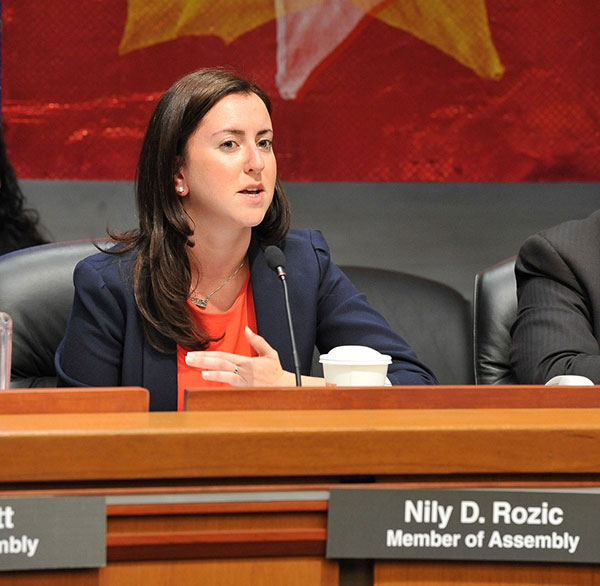
Assemblymember Nily Rozic, the author
“An eating disorder? I wish I had one of those — I could stand to lose a few pounds.”
Every year, clients, advocates, and professionals visit the New York State Capitol to meet with legislators. When discussing their eating disorder experiences and pushing for legislation to ensure proper insurance coverage, too often they are met with that response and others like it.
These kinds of insensitive quips reveal how little many people know about the danger and severity of eating disorders.
No one intentionally jokes about wanting a life-threatening illness. And the truth that too few people understand is that eating disorders are life-threatening mental illnesses. Not a choice; the disorder is a means of coping and can be attributed to a collection of biological, psychological, social, and genetic factors.
Anorexia and bulimia nervosa are the most common disorders but they are not the only ones. Others recognized by the American Psychiatric Association in the Diagnostic and Statistical Manual include Binge Eating Disorder, Avoidant Restrictive Food Intake Disorder, Other Specified Feeding or Eating Disorder, Pica, and Rumination Disorder. All of these disorders are serious and require medical attention.
People who struggle with an eating disorder are doing precisely that — they are struggling. Part of that pain and stigma comes from their symptoms not being understood as dangerous or serious. Often, symptoms are not taken seriously and they must convince not only their loved ones that they are sick but also insurance providers that approve treatment and coverage.
There remains a troubling gap in insurance coverage. Through Timothy’s Law, eating disorders are ensured coverage but only anorexia and bulimia nervosa are named. Insurance providers use this grey area as reasoning to deny coverage of the other eating disorders.
The story is common: Too many people are turned away due to lack of coverage. Too many people lose their chance of a full recovery because they didn’t meet strict weight requirements to classify as anorexic or didn’t throw up often enough each day to be considered bulimic. Not only is it hard to be approved for coverage, it’s even harder to find a comprehensive care center close to home — there are only three across New York.
It is time that law reflects the most current version of known eating disorders. New York can change the story. Earlier this year, I introduced the Eating Disorders Act (A1619/S3101) that would ensure coverage is provided to all people struggling with eating disorders by codifying all the currently recognized disorders.
The time for awareness is now. The time for change is now.
***
New York State Assemblymember Nily Rozic represents parts of Queens. On Twitter @nily.
***
Have an op-ed idea or submission for Gotham Gazette? Email This email address is being protected from spambots. You need JavaScript enabled to view it.
Remembering the Value of the Public Advocate as We Choose the Next One
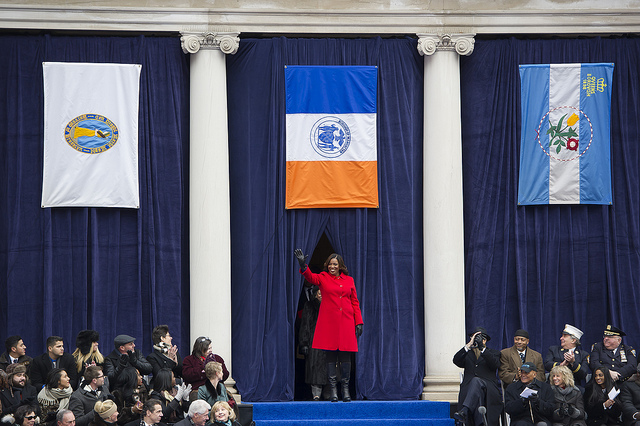
Tish James' inauguration (photo: Mayor's Office)
On Tuesday, Feb. 26, New York City voters will head to the polls to elect the next Public Advocate, a position vacated in January when the previous officeholder, Letitia James, was sworn in as State Attorney General.
New York is the only city in the country that has an elected city-wide Public Advocate, a unique position charged with helping individual residents and addressing broader city service problems. We’re better off for it.
Unfortunately, 30 years after the position was created, too few understand the role of the Public Advocate. And, as New Yorkers head to the polls to vote, there is a simultaneous push to eliminate the office, a move that is misguided and irresponsible.
I served as New York City’s second Public Advocate, from 2001 through 2009. With a budget of around $3 million (that’s about 0.03% of the total city budget) we investigated complaints about city services, proposed solutions, introduced legislation, and held the rest of city government’s feet to the fire to improve services.
We were successful. So were the other four individuals who served in the position.
How?
Sometimes it starts with a single complaint. A family living in a homeless shelter called my office about problems getting food stamps. This led to an investigation uncovering a string of problems both with the food stamp application process and the offices of the Human Resources Administration, the New York City agency responsible for helping people access public benefits.
Other times, the office hears from groups of people, like parents of students who called my office to complain about being backlogged in the special education evaluation process.
In both these cases, and many others, we were able to force the city to fix the service problems. Letitia James did the same for tenants, children in foster care, children with disabilities, and others.
The fact of the matter is, the office has a three-decade-long track record of helping people in the city.
In the face of the facts, a City Council member has introduced a misguided bill to eliminate the office. Those who have sought to shutter the office have two basic criticisms: they claim the office is a stepping stone to higher office and that the role is filled by others. The first is true, but misses the point. The second is 100 percent wrong.
First, every office, aside from the office of the President of the United States, is a potential stepping stone. If the person who holds a term-limited position (all city-wide offices have term limits) does his or her job well, we should want that person to run for higher office and let the voters decide.
Second, there is no other elected official with a city-wide perch who can see service problem patterns from Bensonhurst, Brooklyn to Baychester, The Bronx, connect the dots, and use the power of the bully pulpit and the law (via legislation) to get the problems fixed.
But, after my eight years in the Public Advocate’s office, I realize the office isn’t perfect. Instead of re-debating whether the office should exist, we should talk about strengthening it.
The office needs a guaranteed independent budget. Currently the office’s budget is decided at the whims of the Mayor and City Council, the very entities the Public Advocate is intended to scrutinize.
Furthermore, while I was Public Advocate, we received around 12,000 calls a year about problems with city services. 311, the city hotline for information and complaints, receives tens of millions. The Public Advocate’s office should be linked with 311 to give it a broader view of the problems New Yorkers are experiencing and the trends that need to be brought to the attention of the administration.
As New Yorkers get ready to head to the polls to vote in the next Public Advocate, they should consider which of the 17 candidates would best fit the ombudsman role. And those in government should get to work to strengthen the office and better ensure city services work better.
***
Betsy Gotbaum, a former New York City Public Advocate, is Executive Director of Citizens Union, a government reform organization.
As Executive Director of Citizens Union Foundation, Gotbaum also serves as publisher of Gotham Gazette.
***
Have an op-ed idea or submission for Gotham Gazette? Email This email address is being protected from spambots. You need JavaScript enabled to view it.
Time for the City to Pay Up
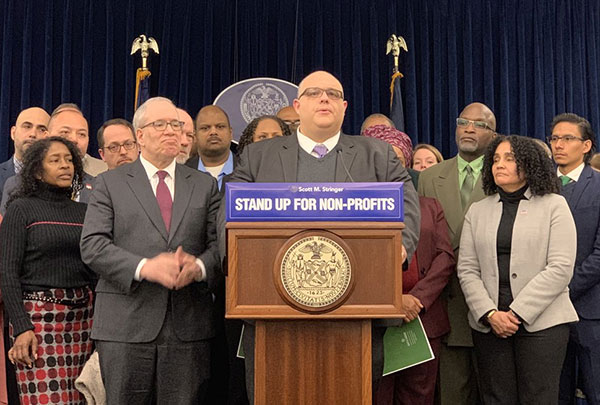
Justin Brannan, the author (photo: @JustinBrannan)
Talk is cheap. The city needs to pay up.
We have all been impacted by the important work of hundreds of human services providers across the city, many of which are deeply rooted in our communities. These vital non-profit organizations deliver services to New York City’s most vulnerable – the poor, the hungry, the homeless, our children, our grandparents. The clear and powerful impact of this sector makes it easy for politicians to praise the services these non-profits provide — but such talk is cheap if you don’t back it up with action.
The uncomfortable truth is that these crucial organizations are very much at risk and in direct harm at the hands of the same government agencies and elected officials who praise them. How so?
Human services contracts are registered late by city agencies 94% of the time, forcing organizations to make impossible decisions to bridge massive gaps in their funding. Ninety-four percent!
In fact, most city contracts with non-profit human services providers are registered months or even years after these non-profits begin providing the services they cover. While this money is being held up by a broken and opaque contracting system, critical support for children, the elderly, those experiencing homelessness, people with disabilities, those living with HIV and AIDS, immigrants, and individuals coping with substance abuse and mental health challenges are put in direct risk.
This is shocking and unacceptable.
A domestic violence shelter cannot close for months while the city gets its act together. Senior centers can’t stop serving daily meals because of a funding gap due to a late payment from the city. Instead, non-profits are forced to front money, taking on costly loans and lines of credit with high rates of interest that are never reimbursed by the city agencies that held up their money up in the first place.
I cannot believe this has somehow become the status quo. It must change.
There are real human and financial consequences if a non-profit doesn’t start its services on time. Not to mention the corresponding challenges for those who work providing these crucial services.
It is time for those responsible for this crisis to step up. Non-profits have borne the brunt of the city’s delays, putting the financial health of their organizations in jeopardy to ensure communities receive critical services. While no contract should ever force a provider to start delivering services before being paid, at the very least non-profits should not bear the cost! Those interest payments must be the responsibility of those at fault and should be paid, in full, by the city, a requirement that would provide a direct incentive to process contracts on time.
It is also important that there is clear public access to data about which city agencies have the longest delays and why contracts are being held up. This information is vital not only to promote accountability but also to seek the needed remedies to this failure.
Contracts and the procurement process may not be the sexiest topic in this city of headlines, but it has an exponentially reverberating effect on the city and how it functions. If we allow this to continue, these compounding late payments to the human services sector will only get worse and soon every neighborhood will suffer the consequences.
As chair of the City Council’s Committee on Contracts, I have heard dozens upon dozens of devastating stories about how organizations are impacted by these unnecessary barriers built around them by the city. Talk is cheap. Action is long overdue – we must act now to address this crisis.
***
City Council Member Justin Brannan represents parts of southern Brooklyn. On Twitter @JustinBrannan.
***
Have an op-ed idea or submission for Gotham Gazette? Email This email address is being protected from spambots. You need JavaScript enabled to view it.
After Amazon: Establishing Our Local Pipeline for Future Opportunities
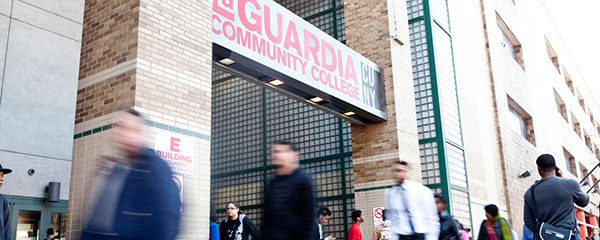
(photo: LaGuardia Community College, CUNY)
With Amazon’s pronouncement to put the brakes on its plan to bring part of its new headquarters to Long Island City, it’s time to make lemonade out of the many lemons left in the wake.
Amazon’s decision to locate here centered on our city’s ability to get the company the talent it needs to grow. It’s what every company, large and small, needs to thrive.
When Amazon first announced it was coming, one of the first questions raised was: who will benefit? Would the 25,000 jobs help our local community, including the residents of Queensbridge Houses, the nation’s largest public housing complex, and LaGuardia Community College, where more than 70% of students come from households with incomes of less than $30,000? What kinds of jobs would be open to someone with just a high school diploma, an associate’s, a bachelor’s? Would it be New Yorkers who benefitted, or people recruited from elsewhere in the country and the world?
In my engagement with City, State, and Amazon representatives, it became clear to me that New York (and conceivably many localities) needs a stronger, integrated system that links private and public spheres to educate future employees. Amazon’s proposed campus in Long Island City highlighted the need for that more robust, sustained development of talent pipelines in the fundamental field of tech, especially for people in low-income communities.
The first step is more employers willing to establish long-term partnerships with local colleges and universities so there’s clear understanding of the technical, intellectual, and practical skills needed for job-openings. Without strong employer partnerships, we can’t be certain that our students will be job-ready upon graduation.
We need more companies, especially tech companies, willing to invest in developing local talent by providing paid internships and mentorship opportunities for nontraditional and traditional students alike. We need more collaborations to create job-specific training programs, like one we have with Google to provide training in IT support.
Without far-reaching programs that connect students who are older, poor, or speak English less than well, tech employers will continue relying on the same private and elite-college networks for hiring.
Fledgling progress was being made with Amazon to create pathways to jobs. At the end of January, Amazon announced a collaboration with LaGuardia Community College, CUNY, and SUNY to create a program to train people (with at least a high school diploma) for jobs in cloud computing.
But more than programs, public officials, employers, and educators must convene and nurture the building of an ecosystem that connects the many assets a community can use to establish a collaborative approach. If a community can encircle a potential employee with support and education, and companies can create bona fide paths to employment, there is no limit to the amount of social mobility and community vibrancy that can be created.
LaGuardia Community College knows how well employer-education partnerships can work when it all comes together. Queens resident Matt O’Connor was working full-time packing boxes at a nearby delivery service when he came to LaGuardia to channel his passion for coding. He was offered internship opportunities that grounded his classroom work. Matt first interned at the tech accelerator Entrepreneurs Roundtable Accelerator, where he worked with small tech start-ups. His next paid software development internship was at Place Pixel, a company that creates next-generation mapping experiences. It went so well that he was offered a full-time job with an equity share in the company. Matt said it felt miraculous when he was able to quit the package delivery company. Today, he’s a full-time software engineer at the company SevenFifty.
But with better and more targeted resources, we can do even more. We need elected officials to step up and increase the investment in our public colleges: to give us the resources to re-imagine what and how we teach. We need to be able to hire and support full-time faculty who can effectively teach complex material, particularly to a diverse student body. We need the funding to support the collaboration across organizational silos. It’s not just the funding for expanding holistic support like child care, and philanthropy to support transportation, emergency funds, and an on-campus food pantry. It’s also dedicated funding to link the path from the housing projects to training, and from training to college.
Over the coming weeks and months, there will be much analysis of what went right or wrong with the Amazon deal. No matter who declares victory, what Long Island City is left with does little for the low-income and aspiring New Yorkers who remain on the sidelines. Let’s not lose a moment in getting our talent prepared for whatever happens next, whether it’s the next Amazon wanting to locate here or the start-up just beginning to get launched.
Whether you are cheering or bemoaning the crumbling of the agreement, we can all agree those who’ve been historically locked out of job opportunities in the fastest growing industries need more pathways to these good, steady jobs that enable them to provide for themselves and their families.
***
Gail O. Mellow is President of LaGuardia Community College. On Twitter @LaGuardiaCC.
***
Have an op-ed idea or submission for Gotham Gazette? Email This email address is being protected from spambots. You need JavaScript enabled to view it.
The Right Way to Legalize Surrogacy in New York
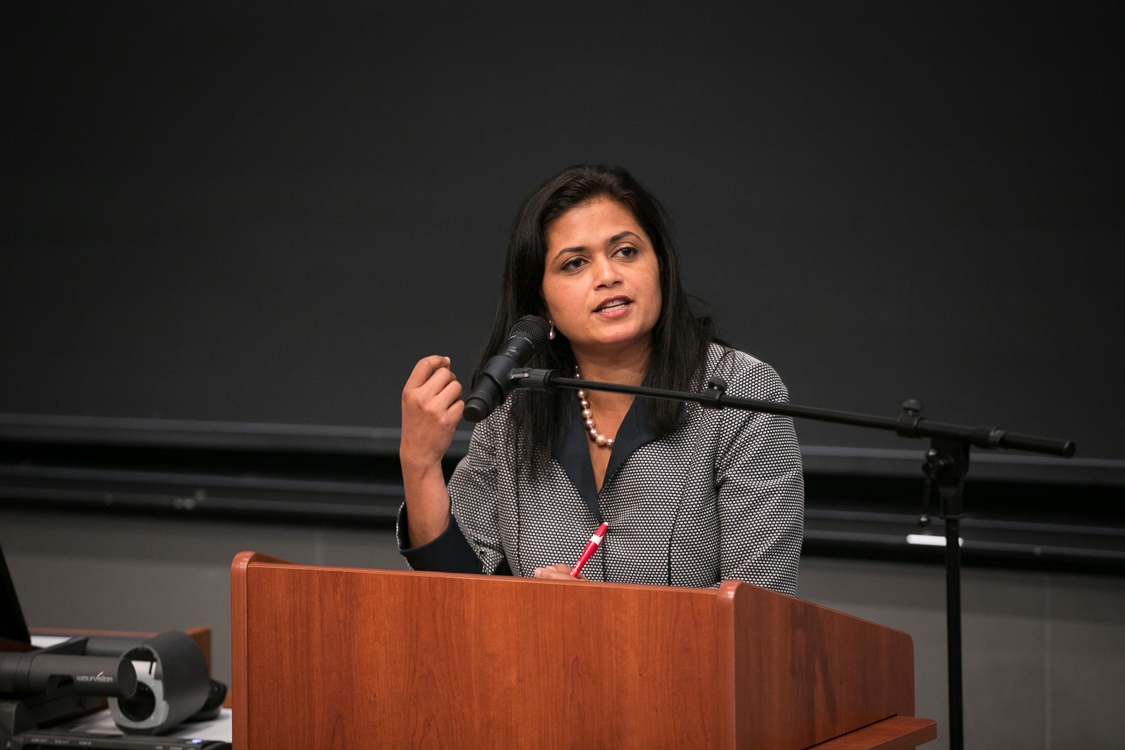
Sital Kalantry, the author (photo: Cornell Law School)
New York State is on the brink of replacing an outdated and prohibitive law that criminalizes the practice of compensated surrogacy, one of only two states that does so. Legislation to reverse the law has been introduced in both houses of the state Legislature, and Governor Cuomo has demonstrated support for it by including it in his Executive Budget.
As a law professor who focuses on gender equity, I’ve taken great interest in issues related to surrogacy in the United States and abroad. I’ve closely reviewed laws in multiple states as well as internationally, and I support New York’s legalization of surrogacy.
When a woman chooses to support a couple or individual by serving as a gestational surrogate (where she is not genetically connected to the child because she did not contribute her egg), I believe she must have the autonomy to do so – provided she is protected by the law to ensure that any power imbalance between her, on the one hand, and the intended parents, surrogacy agencies and doctors, on the other hand, is mitigated.
The proposal the New York Legislature is considering and that Governor Cuomo is advancing, the Child-Parent Security Act, does protect surrogates in many ways. While the bill clarifies the parentage of all children born through third-party reproduction, here I focus only on how it legalizes and regulates gestational surrogacy arrangements.
Protections provided by the bill include: giving the surrogate the sole right to make decisions regarding her own health or that of the fetus or embryo she is carrying; giving the surrogate the sole right to terminate the pregnancy; and ensuring that the surrogate is represented by her own legal counsel. These types of commonsense protections are critical to creating a successful and effective program. If the New York Legislature passed the Child-Parent Security Act, New York’s law would be more protective of women who choose to be surrogates than laws in many other states.
Reexamining current law is long past due as technological advances and changes in acceptance of various family structures have made surrogacy much more commonplace. When lawmakers first implemented a ban on surrogacy in New York in 1992, they did so for several reasons that are less relevant today.
For example, when the restrictive New York law was enacted, there were ethical concerns about what was then nascent medical treatment -- in vitro fertilization (IVF). Today, IVF is commonly-accepted as treatment for infertility and is also used in the gestational surrogacy process.
Despite the ban, today New Yorkers do work with surrogates to build families. They are just required to employ surrogates living in other states. This results in legal challenges, risks, and costs for the intended parents, including confusion regarding what laws are applicable to the situation.
It’s past time for New York to modernize its laws so that intended parents in New York can work with surrogates in their own state, with laws supporting and protecting both, and for surrogates who want to help intended parents start their family to be able to do so. Just last year New Jersey legalized gestational surrogacy moving beyond the restrictive approach to surrogacy that was articulated in its famous Baby Mcase in 1988. I wholeheartedly encourage the New York Legislature and Governor to approve this important measure this year.
***
Sital Kalantry is a Clinical Professor of Law, Director of the International Human Rights Policy Advocacy Clinic, and Co-Director of the Migration and Human Rights Program at Cornell Law School. On Twitter @skalantry.
***
Have an op-ed idea or submission for Gotham Gazette? Email This email address is being protected from spambots. You need JavaScript enabled to view it.